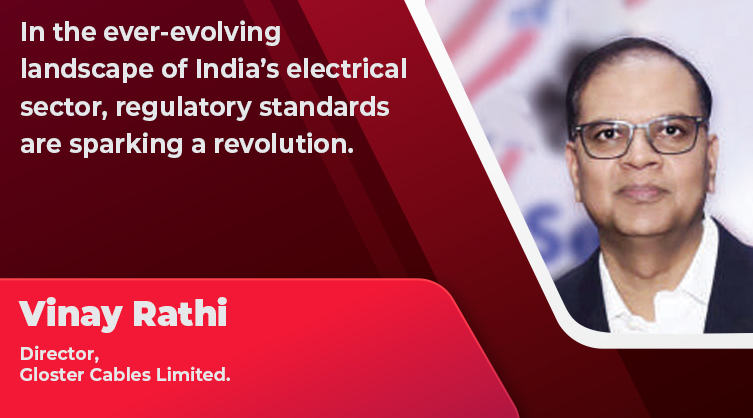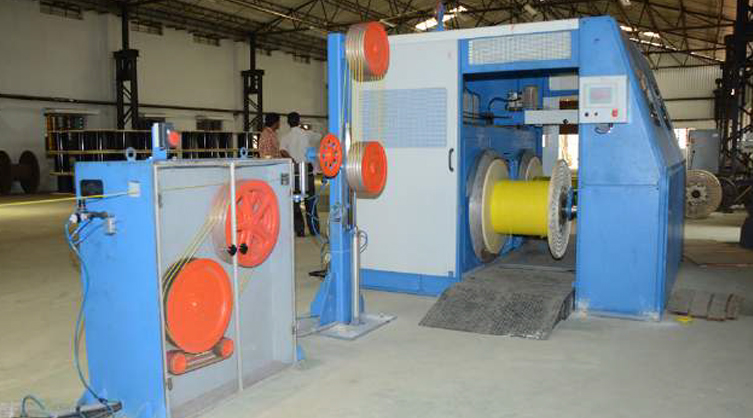Navigating the cable challenges in India’s electrical infrastructure
By EPR Magazine Editorial September 26, 2023 2:37 pm IST
By EPR Magazine Editorial September 26, 2023 2:37 pm IST

In the ever-evolving landscape of India’s electrical sector, regulatory standards are sparking a revolution.
The evolving regulatory standards in the Indian electrical sector have several impacts on the manufacturing and distribution of wires and cables. The change in regulatory standards is reshaping how manufacturers and distributors of wires and cables operate, and the implications are far-reaching.
One of the most significant impacts of these evolving standards is the noticeable improvement in the quality and safety of electrical products. Large and small firms are investing substantially in compliance measures, from research and development to testing and certification. This investment, though necessary, has a direct effect on pricing. Gloster Cables, for example, faced the challenge of balancing compliance costs while keeping their products affordable.
Amid the challenges of regulatory evolution, the electrical sector has witnessed a surge in innovation. Companies have embarked on a journey of continuous improvement, pushing the boundaries of their product development to meet and exceed these standards. One of the crucial aspects of evolving regulations is their growing emphasis on eco-friendliness. These standards often promote the use of environment-friendly materials and manufacturing processes. Customers increasingly choose their products because they comply with safety and quality regulations.
The regulatory shift has also prompted significant adjustments in supply chains. Material sourcing and logistics have come under scrutiny, and companies work diligently to ensure that every component meets the evolving standards. This has also affected continuous investment in testing, and certification has become a norm in the industry.
A silent debate rages on the choice between copper and aluminium conductors in the vast landscape of India’s electrical systems. Each metal comes with its unique set of characteristics, and the impact of this decision can ripple through projects, budgets, and long-term performance.
Copper, often hailed as the gold standard in electrical conductors, boasts remarkable efficiency, leading to minimal energy loss. It’s the go-to choice for those seeking top-notch performance and durability. However, it is higher in cost and significantly heavier than its counterpart. On the other hand, aluminium beckons with its cost-effectiveness and is readily considered for large-scale projects. It costs less and is lighter in weight, too. But here’s the trade-off it’s less efficient, leading to more energy loss, and it’s prone to the relentless march of corrosion.
The choice between copper and aluminium isn’t one-size-fits-all. It’s a complex puzzle influenced by numerous factors. For small projects focusing on long-term performance, copper often takes the spotlight. Its efficiency and durability are cherished, even if the initial investment is steep. Conversely, aluminium shines in the realm of colossal installations. Its cost-effective nature aligns with the budgetary needs of large-scale endeavours. However, it’s vital to remember the trade-offs of higher energy loss and the ever-present threat of corrosion.
Project size, budget constraints, local climate conditions, and a meticulous long-term cost analysis all play a role in the decision-making process. It’s a nuanced choice, where copper’s performance prowess battles aluminium’s budget-friendly allure. In India’s electrical landscape, this debate still needs to be settled, and the decision ultimately rests on the delicate balance between efficiency, budget, and long-term goals.

India’s electrical sector is undergoing a transformative journey, presenting opportunities and challenges for manufacturers and consumers. Technological advancement stands at the forefront, driving innovation and efficiency in the industry. Manufacturers who invest in cutting-edge technologies can harness the potential for increased demand domestically and globally, making India a hub for electrical equipment production. The emphasis on research and development further paves the way for groundbreaking solutions.
However, the path has hurdles. High initial investment poses a significant challenge for manufacturers, demanding careful financial planning. Ensuring quality assurance amidst competition is another critical concern. Compliance with ever-evolving regulations adds complexity to the landscape.
Conversely, consumers benefit from improved connectivity and the advent of smart infrastructure, offering convenience and efficiency. Innovation in electrical solutions promises a more sustainable and convenient future. Yet, the initial costs for these advanced systems can be prohibitive. Navigating the technicalities of these innovations may also be daunting for some, and the growing concerns surrounding security and privacy in the digital age add a layer of caution. As India’s electrical sector evolves, stakeholders must weigh these opportunities and challenges to ensure a brighter and more connected future.
The Indian electrical sector is shifting profoundly towards sustainability and environmental consciousness, with far-reaching implications for the design, production, and disposal of wires and cables.In the design phase, manufacturers increasingly embrace eco-friendly materials like lead-free and PVC-free insulation, aiming to reduce the environmental impact. Prioritising energy efficiency is also a cornerstone, focusing on minimising energy losses during transmission to lower greenhouse gas emissions. Additionally, cables are being engineered for durability to extend their lifespan, thus reducing the need for replacements and curbing resource consumption and waste.
Green manufacturing processes are gaining ground on the production front, emphasising efficient resource utilisation, emissions reduction, and waste minimisation. Some manufacturers are incorporating recycled materials into cable production, diminishing the demand for virgin resources and reducing waste. Sustainable packaging options, including recyclable materials and reduced packaging waste, are also making headway.
In the disposal realm, efforts are underway to establish recycling programs for old wires and cables, preventing their burial in landfills and allowing for the recovery and reuse of valuable materials like copper and aluminium. Guidelines for environmentally responsible disposal are promoted to mitigate environmental contamination and health risks. Furthermore, Extended Producer Responsibility (EPR) initiatives may compel manufacturers to take charge of their product disposal, incentivising designs that are easier to recycle or dispose of responsibly.
Manufacturers are pursuing eco-certifications, emphasising sustainability. Green supply chains are prioritised, including cable suppliers. Rising environmental awareness drives consumer and business preferences for eco-friendly wires and cables. Government regulations reinforce sustainable practices, reshaping the electrical sector for a greener future.
In India, the decision between overhead and underground cables is multifaceted, shaped by several key factors that carry significant implications for reliability, maintenance, and urban planning.
Cost plays a pivotal role, as underground cables tend to be pricier to install than their overhead counterparts. Aesthetic and urban planning considerations come into play, especially in densely populated urban areas and heritage zones, where underground cables’ clean, uncluttered look is preferred.
Reliability is a critical factor, with underground cables being less vulnerable to weather-related damage in regions prone to storms and harsh conditions. Space availability also influences the choice, as overhead cables require real estate for poles and wires, which can be lacking in congested urban areas.
Maintenance and accessibility diverge between the two options, with overhead cables offering easier access for repairs but requiring frequent attention. Underground cables, while more resilient to weather disruptions, demand specialised equipment and expertise for fault location and repair.
Urban planning is significantly impacted, with overhead cables potentially obstructing views, affecting property values, and interfering with development plans. Conversely, underground cables contribute to a cleaner urban aesthetic, aligning with urban planning objectives.
Ultimately, the choice between overhead and underground cables must be a carefully weighed decision, considering these factors in the specific context of each region’s needs and goals.
Spokesperson – Vinay Rathi, Director, Gloster Cables Limited
We use cookies to personalize your experience. By continuing to visit this website you agree to our Terms & Conditions, Privacy Policy and Cookie Policy.